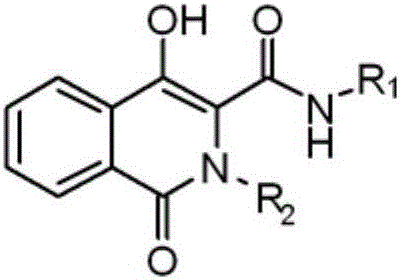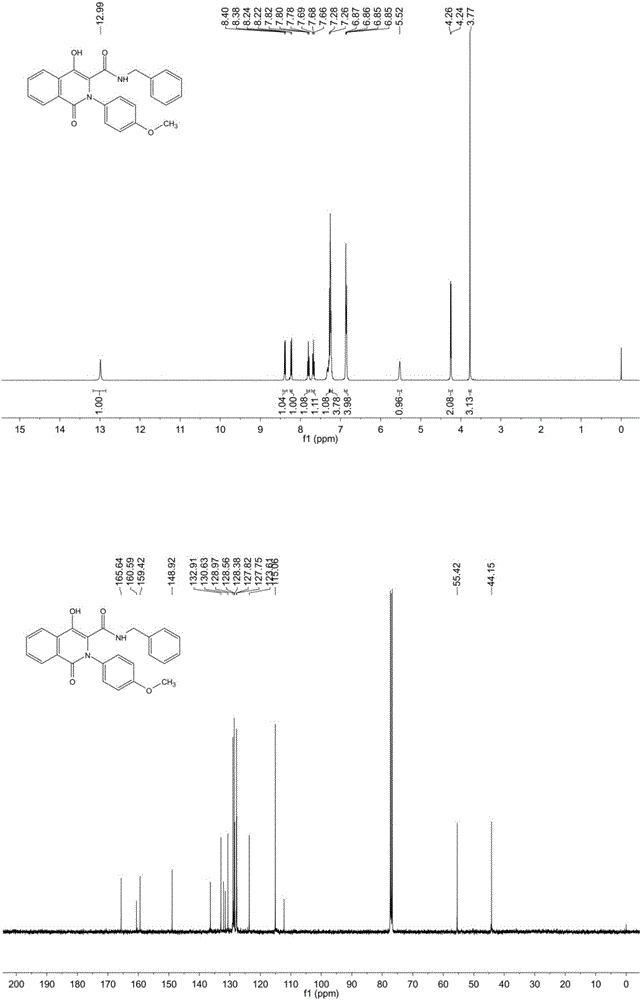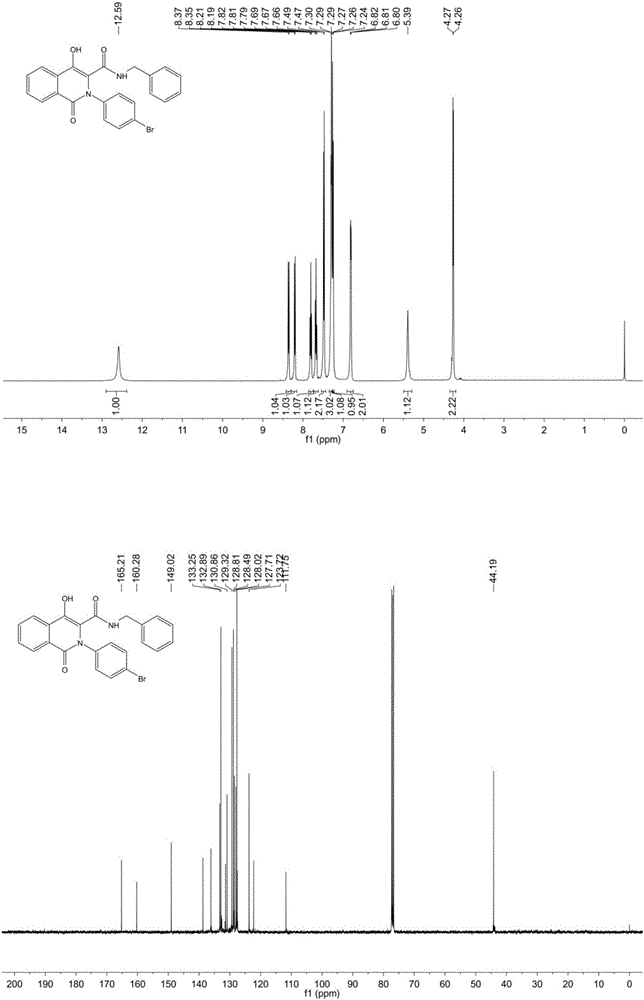Synthetic method of 4-hydroxyquinolinone derivative and application in anti-tumor research
A technology for hydroxyquinolinone and derivatives, which is applied in the field of synthesis of 4-hydroxyquinolinone derivatives, can solve problems such as unreported new structure compounds of 4-hydroxyquinolinone, and achieves low cost and simple operation process. , the effect of short synthetic route
- Summary
- Abstract
- Description
- Claims
- Application Information
AI Technical Summary
Problems solved by technology
Method used
Image
Examples
Embodiment 1
[0044] where R 1 is an alkyl group, R 2 is an aryl group, that is N -Synthesis of benzyl-4-hydroxyl-2-(4-methoxyphenyl)-1-oxo-1,2-dihydroisoquinoline-3-carboxamide, the specific steps are as follows:
[0045] In a 10-mL microwave reaction tube, ethyl glyoxylate (1.5 mmol) and methoxyaniline (1.0 mmol) were dissolved in 2.0 mL of methanol solution, followed by monomethyl phthalate Ester (1.0 mmol) and benzyl isocyanide (1.0 mmol) were sequentially added to the solution, the reaction solution was stirred overnight at room temperature, and then the isocyanate was detected by thin-layer chromatography. If there was no remaining isocyanine raw material, the solution was used Blow dry with nitrogen, then dissolve with 5.0 ml of dimethylformamide (DMF), then add 1,8-diazabicyclo(5.4.0)undec-7-ene (DBU) (2.0 mmol) , in a microwave oven at 90 o C for 10 minutes. The solution was diluted with ethyl acetate (15 ml), and washed three times with 20 ml of saturated brine. After the or...
Embodiment 2
[0048] where R 1 is an alkyl group, R 2 is an aryl group, that is N -Synthesis of benzyl-2-(4-bromophenyl)-4-hydroxyl-1-oxo-1,2-dihydroisoquinoline-3-carboxamide, the specific steps are as follows:
[0049] In a 10 mL microwave reaction tube, first dissolve ethyl glyoxylate (1.5 mmol) and 4-bromoaniline (1.0 mmol) in 2.0 mL of methanol solution, and then add phthalate monomethyl Ester (1.0 mmol) and benzyl isocyanide (1.0 mmol) were sequentially added to the solution, the reaction solution was stirred overnight at room temperature, and then the isocyanate was detected by thin-layer chromatography. If there was no remaining isocyanine raw material, the solution was used Blow dry with nitrogen, then dissolve with 5.0 ml of dimethylformamide (DMF), then add 1,8-diazabicyclo(5.4.0)undec-7-ene (DBU) (2.0 mmol) , in a microwave oven at 90 o C for 10 minutes. The solution was diluted with ethyl acetate (15 ml), and washed three times with 20 ml of saturated brine. After the org...
Embodiment 3
[0052] where R 1 is an alkyl group, R 2 is an alkyl group, that is, 4-hydroxy-2-isobutyl-1-oxo- N -Synthesis of phenethyl-1,2-dihydroisoquinoline-3-formamide, the specific steps are as follows:
[0053] In a 10 mL microwave reaction tube, first dissolve ethyl glyoxylate (1.5 mmol) and 2-isobutylamine (1.0 mmol) in 2.0 mL of methanol solution, and then add phthalic acid Monomethyl ester (1.0 mmol) and phenylethyl isocyanide (1.0 mmol) were sequentially added to the solution, the reaction solution was stirred overnight at room temperature, and then the isocyanate was detected by thin-layer chromatography, if there was no remaining isocyanide Raw materials, the solution was blown dry with nitrogen, then dissolved in 5.0 ml of dimethylformamide (DMF), and then added 1,8-diazabicyclo(5.4.0)undec-7-ene (DBU) ( 2.0 mmol), 90 in the microwave o C for 10 minutes. The solution was diluted with ethyl acetate (15 ml), and washed three times with 20 ml of saturated brine. After the o...
PUM
 Login to View More
Login to View More Abstract
Description
Claims
Application Information
 Login to View More
Login to View More - R&D
- Intellectual Property
- Life Sciences
- Materials
- Tech Scout
- Unparalleled Data Quality
- Higher Quality Content
- 60% Fewer Hallucinations
Browse by: Latest US Patents, China's latest patents, Technical Efficacy Thesaurus, Application Domain, Technology Topic, Popular Technical Reports.
© 2025 PatSnap. All rights reserved.Legal|Privacy policy|Modern Slavery Act Transparency Statement|Sitemap|About US| Contact US: help@patsnap.com



